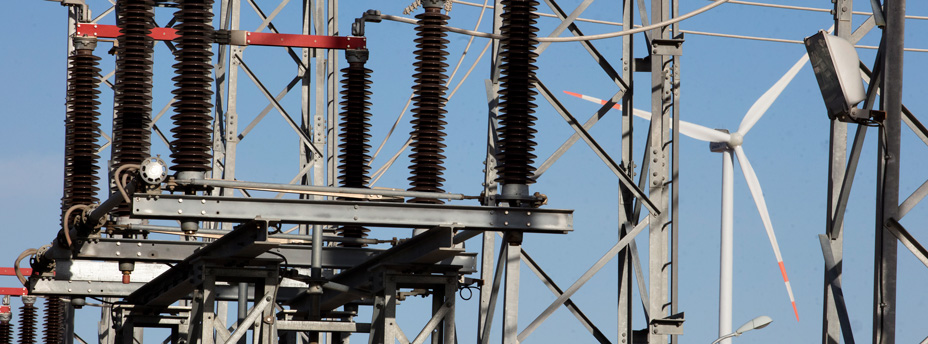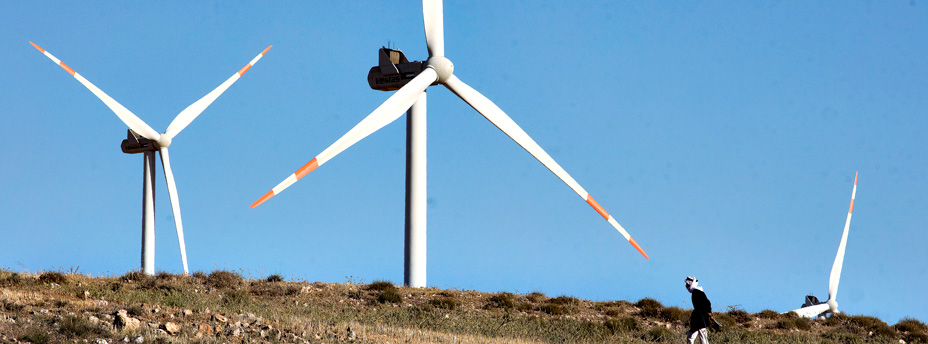The Tafila Wind Farm can power 80,000 homes, helping transform Jordan into a clean-energy powerhouse. © Dominic Chavez/IFC
| This story is part of a series on IFC’s work to help create markets that give new opportunities to people in developing countries. These innovative approaches have helped solve some of the largest problems in countries or, sometimes, entire regions. |
 Head southeast from the Dead Sea and you'll soon find yourself in Tafila, the smallest of Jordan's 12 governorates.
Head southeast from the Dead Sea and you'll soon find yourself in Tafila, the smallest of Jordan's 12 governorates.
It's here that the rocky mountains of the Jordan Valley give way to the vast Arabian Desert. This is a harsh and sparsely populated land—and it has become increasingly important to the country's future.
That’s because it’s home to the Tafila Wind Farm, the first privately financed renewable-energy project implemented in Jordan. The facility, which can power 80,000 homes, is at the forefront of a push by resource-poor Jordan to transform itself into a clean-energy powerhouse.
"Jordan is a country that lacks oil and gas reserves," says Samer Judeh, Chairman of the Jordan Wind Project Company, which built Tafila. "This wind farm is a pioneering project. The whole country is excited."
IFC played a key role in Tafila's creation, including working early on with the World Bank to help the government implement the regulatory and legal reforms necessary to ensure best practices and the overall bankability of the project structure.
IFC also spearheaded a $221 million financing package that backed the plant. The funding is part of IFC’s larger effort to kick-start the development of Jordan's renewable-energy industry and create a market for green power. Since 2013, IFC has arranged more than $500 million in financing for wind farms and solar projects in the country.
Powering Progress
Jordan aims to generate 20 percent of its power from renewable energy by 2020. The 117-megawatt Tafila plant marked an important step in that direction, clearing the way for an additional 600 megawatts of renewable-energy projects that came later.
Jordan’s effort is two-pronged. First, Jordanian officials are eager to reduce the nation’s dependence on foreign fuel, which until recently had generated 97 percent of its power. Second, leaders see the tremendous potential of clean energy to transform Jordan’s future.
"The specter of climate change looms large over Jordan—as it does for many other countries in the Middle East and North Africa,” says Mouayed Makhlouf, IFC Regional Director for MENA. "Large-scale renewable-energy projects such as Tafila are crucial for lowering greenhouse-gas emissions and putting the region on the path to sustainable development."
IFC also took the lead in arranging a $200 million financing package for a series of small solar-power plants in Jordan, collectively known as the Seven Sisters. The program is the largest privately backed solar project in the region, and is serving as a template for a dozen other plants now under consideration.
In addition, IFC arranged a $76 million financing package for Fotowatio Renewable Ventures, helping the company build a 50-megawatt solar-power plant in northern Jordan. The World Bank Group has worked closely with the Jordanian government to overhaul electricity laws. That has encouraged private power companies to enter the market, easing the government’s fiscal burden.
The shift to renewable energy is an important part of Jordan's efforts to stabilize its budget. "Jordan will prosper if it starts depending on its own [resources], and if it allows the private sector to participate in its [development] programs," says Prime Minister Hani Al-Mulki.
Tafila’s wind turbines are impressive—each blade measures 55 meters, half the length of a football field. But the greater significance of the plant is how it paved the way for other national renewable-energy projects. After Tafila, the government and private sector agreed on $1.6 billion worth of investments in wind farms and solar arrays.
“It opened the door,” allowing Jordan to use its available natural resources to maximum advantage, says Judeh, Jordan Wind’s chairman, as he stands on a rocky hill overlooking an array of turbines. “I feel very proud and very humbled that we were able to accomplish this.”
Related Story: With Sustainable Approach, Jordan’s Wind-Power Industry Soars
To learn more about IFC’s work in energy, visit www.ifc.org/infrastructure
Follow the conversation: #IFCmarkets
Also available in: عربي
Published in June 2017




